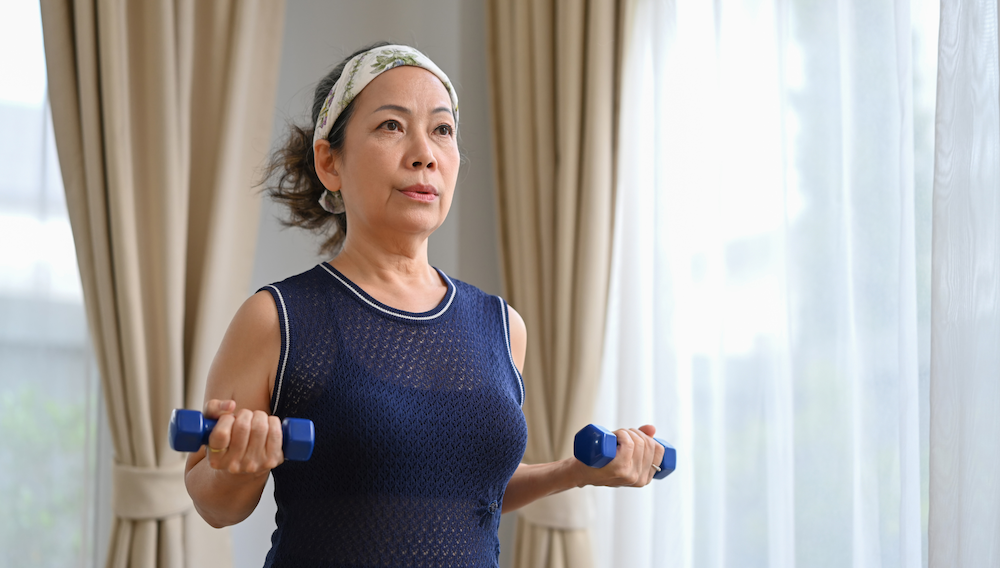Mammograms are one of the best diagnostic tests for detecting breast cancer early, and your annual exam in your doctor’s office also includes a clinical breast exam. Another path to detecting breast abnormalities early is through breast self-exams. Our OBGYN staff believes it is always a good idea to be familiar with your body just in case you notice changes. That is why we recommend monthly breast self-exams. Through regular familiarity with your breast tissue, you are more likely to detect a change in the way the breast tissue feels or looks.
You can do a breast self-exam at any time, but the most comfortable time is right after your period. At that time, there should be less tenderness than right before your period. Here are a few things to know about performing a breast self-exam.
Look for Visual Changes
First, stand in front of a mirror with your arms by your sides. Are your breasts smooth of lumps and dimples? Are your nipples inverted? Turn to each side to view your profile. Raise your arms and view your armpits, as well. Look for anything outside of your normal appearance. That could include areas of redness or discoloration, depressions or tightness in the skin, and other noticeable differences. Some kinds of cancer are more like spaghetti than lumps. This makes them difficult to detect, but if your breasts are not pointing the same direction, this may indicate a change that you can’t see under the skin. The more familiar you are with how your breasts look on a daily basis will help ensure that you know when to call your doctor about an abnormality.
Perform the Self Exam
You can perform a self-exam in the shower or lying down. As you begin the manual part of the self-exam, you will want to develop a pattern and method so you can more easily remember the feel and detect changes. Plan to use the pads of the middle fingers on your hand to feel the tissue with different levels of pressure. Follow a slow, methodical approach. Begin at the collarbone and move back and forth in sections down each breast. Go all the way to the underarm and rib cage area. Apply different levels of pressure in each area.
If a spot hurts or is numb or feels lumpy, make a note of where that is. Some people find it helpful to chart their breasts so they have a baseline for how their tissue feels. Again, performing this monthly provides the best way to monitor your breast health. If you have questions about how to perform your breast self-exams, please let us know.

Pay Attention to Physical Symptoms
Some symptoms tell us about possible infections or problems. If you have detected any discharge from the nipple, make note of the color, consistency, and any odor. These symptoms can indicate mastitis or other issues. Other physical symptoms include pain, although it can sometimes be difficult to detect the difference between a pulled or strained pectoral muscle and other types of breast pain. Pain isn’t normal, so if it persists, you should make an appointment for a clinical exam.
So, what are other indications that you should see your doctor? If you feel a hard lump anywhere on your breast or near your underarm, or feel changes like fullness or thicker tissue, you should make an appointment with your doctor. If you see bloody nipple discharge, unusual puckering or bulging or a recently inverted nipple, call your doctor. They can perform a clinical exam to determine the cause, and they may order a mammogram or other diagnostic tests. There is no reason to panic when you find these changes. Many changes in breast tissue are benign. Some changes occur due to aging or the stage of your menstrual cycle.
Keep Your Annual Exam Appointment
One of the best ways to control your health is through your annual exam. At this appointment, you will receive a clinical breast exam. Your OBGYN will perform the exam, following a similar procedure to the breast self-exam. You can share what you’ve observed about your breasts, ask questions, and get information about your risk factors. We recommend that women start annual mammograms at age 40. If you have a family history of breast cancer then you may qualify for genetic testing and annual breast MRIs. This can help ensure the early detection of breast cancer.
Mammograms have come a long way in recent years, with a 3D option available from some providers. Using the same machine setup as regular mammograms, the 3D mammogram is a high-resolution method that is especially good for women with dense breast tissue. Dense breast tissue, as opposed to fatty breast tissue, can be difficult for a radiologist to read on a regular mammogram. The breast self-exam will not help you detect the density of your breasts—density is only an issue for mammograms. Read more about dense breast tissue on the National Cancer Institute website.
We always encourage all of our patients to do everything in their power to take control of their health. One of the ways to do this is by performing monthly breast exams at home. It’s an easy way to know your body and potentially detect changes that can indicate minor or serious health issues. Please let your physician at West Des Moines OB/GYN Associates know if you have questions about breast self-exams, breast cancer risk factors, or mammograms.


